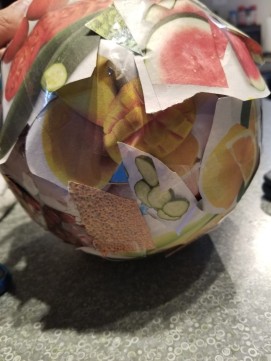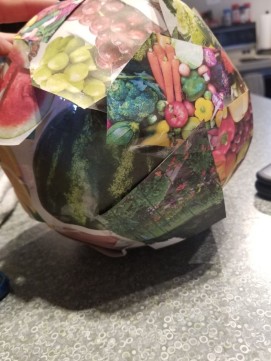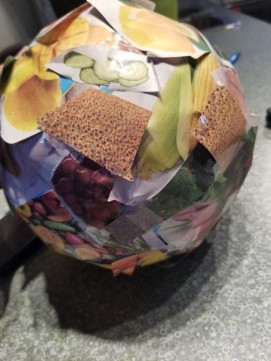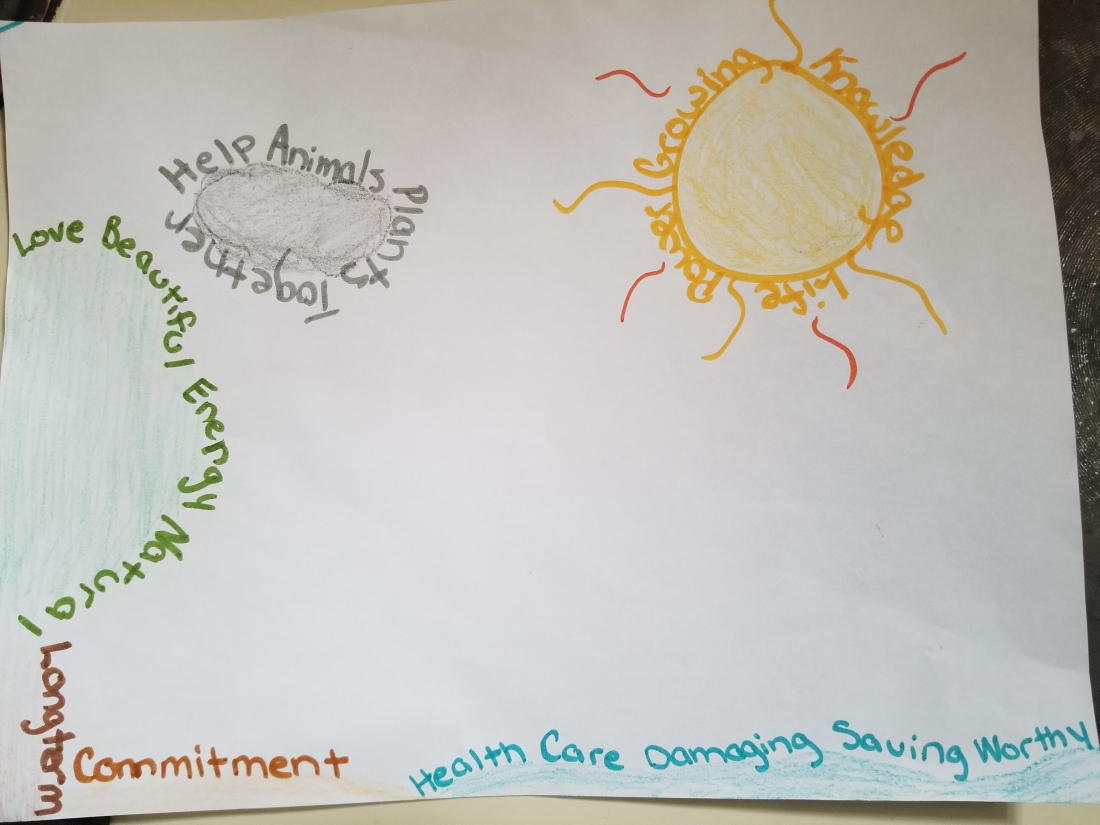Eco- Literacy Poem
Our world is full of beauty and grace,
But our footsteps have left a negative trace.
We’ve dirtied the waters and taken down the trees,
We’ve polluted the air and endangered the bees.
We need to stop and be more aware ,
Our planet, our home needs more love and care.
If we stopped and did our own little part,
Future generations might believe that we have a heart.
For if we leave them in dirt and despair,
The world will be smoggy and bare.
Our world is full of beauty and grace,
Lets let our footprints leave a positive trace.

# 4 – Earth Offerings
When I think of “ceremonies”, I think of funerals, weddings, family gatherings such as thanksgiving and days we set to celebrate each other. Home-made ceremonies to me are using your surroundings and the senses from within yourself. I think I could offer the earth my understanding of how the earth runs and what it requires to survive. I can also offer the earth my ability to unlearn my bad habits and past mistakes, show my respect of the earth, and environment by educating myself while creating new environmentally friendly choices and habits. I can include supporting the earth within its natural habitat in my ceremonies, using the bare minimum and leaving no trace behind me.
The quote “The dominant industrialized culture has resulted in a false dichotomy manifesting a metaphor of hierarchy that promotes human over nature, industry over subsistence, mind over body, reason over emotion, white body over black and brown bodies” (Yi Chien Jade Ho. “Traveling with a World of Complexity”, pg. eight) really made me reflect on all the different ways I have been a part of the problem. Even the little decisions/acts that I have done in the past, as small as they may have seemed to me, they noticeably have huge impacts on the earth, nature and other peoples’ emotions. I had mixed feelings with my visual today, I wanted to show a side of untouched nature, I also wanted my perceptions to come across with a presence of the environment, the footprints I created on the floor were to show how I will follow in the correct footsteps, those full of knowledge and awareness, while allowing others to learn and follow my actions and/or ideas in the future.brittanyholmes4ESCI 302Leave a commentJune 13, 2018 1 MinuteEdit”CJ # 4 – Earth Offerings”
CJ #3 – Wilderness
“Often, the goal of outdoor environmental education is to raise student consciousness and concern for environmental destruction, as a mode of intervention which may shift individual consumption practices, sometimes referred to as anecological footprint” (Mclean, pg. 356). I chose this visual because it reminded me of what I have always thought when I think of wilderness, mixed with what I was shown (natural and animals surrounded by man-made structures, ex. fence). Growing up, we did go on a lot of “wilderness” field trips, However, I think they focused on the wrong things. We spent a good part of the day travelling from the school to locations where we could see and learn about certain animals and trees. When we got there I just remember walking around on all these man-made walkways or bridges and stopping once in a while to get spurts of information. They would focus on what these birds were called, where they came from, and that they were becoming endangered. I understand their attempts in teaching us and changing our ways, however, at that age, I really didn’t understand it and to be honest, I really didn’t care about birds. Maybe if they found a way to show us how it is all interconnected and how our choices that impact birds are also impacting so many other things, it might have actually stuck with me and created a change in our young minds.
I also would have liked to see a more natural side to nature so that as a young student, I could have compared the two and seen the impacts we as humans have made. Being able to understand how all aspects of “wilderness” truly exist in its “home” state. “Yet wilderness is neither natural nor neutral, but cultural and hegemonic, written through relations of power” (Newberry, pg. 34). I think this is an important quote because the cultural aspect of wilderness is quite often forgotten. Going on these “field trips”, I never learned about anyone’s background, nothing about the land specifically, who got here first, what has happened on that land, nothing. I believe in order to truly understand something, to truly change something, we need to be fully aware of the whole truth, past and present.brittanyholmes4ESCI 3021 CommentJune 6, 2018 1 MinuteEdit”CJ #3 – Wilderness”
Eco-Literate Braid
Being eco-literate to me means to have a clear understanding of how our earth survives and knowing how our decisions and actions can truly impact its well being. Both my eco-literate poem and Savannah’s eco-literate poem shows the beautiful and natural areas of our earth (“The land, water, trees, mountains around us are ours to foster”) and our reflections of the it. We both described how us as humans are destroying the land and the well being of the world, we need to make a change in order to save the beauty that “surrounds us with harmony and all that is interconnected”. I think Savannah included more of her relationship with the environment, which my poem was lacking. Showing how you can connect with the environment creates more of a cause or reasoning to fight for its health.
Both my eco-literate poem and Madison’s eco-literate letter shows the impacts that humans are causing on our world. Madison’s letter shows all the different ways in which the character is contributing to make our environment healthy again, where my poem gives examples of the ways we have damaged our land. I think if we had an article with both our poem/letter combined, It could be a good way for people to be reminded of all the things we do day to day without realizing that they are hurting our environment drastically (“We’ve dirtied the waters and taken down the trees”), followed by some examples of other acts you could follow day to day to help reverse our damaging ways (“You take public transport, you’re a vegetarian, you shop local, you recycle and compost”).
In all our pieces, it is clear that we all want to see a change, they all had the idea of changing our everyday lives to help “save” the world. It is important to use your knowledge and experiences while intertwining the knowledge and experience of your peers, this way you can get an understanding from all angles.brittanyholmes4ESCI 3021 CommentMay 29, 2018 1 MinuteEdit”Eco-Literate Braid”
My Leap Into Action
I have committed to eating less meat in order to start my part in bettering our earth. A team of researches calculated all the costs of producing all different kinds of meat compared to the cost of producing other common food types. They discovered that producing meat (no matter where it is in the world) releases a lot more climate-warming pollution than it would to produce fruits, nuts, grains and vegetables. There are a lot of costs all together to producing any type of good or food. Producing takes a lot of resources, resources such as; water for the animals and crop fields, fertilizer and chemicals, and a huge amount of gasoline or diesel that fuels all the farm machinery, and transportation vehicles.
“This is our sacred duty to those this country harmed in the past, to those suffering needlessly in the present, and to all who have a right to a bright and safe future.
Now is the time for boldness.”
For my visual representation, I created an earth-like collage. A ball in the shape of earth and covered it in pictures that reminded me of the foods that I think can help the world change. Foods such as corn, carrots, tomatoes, watermelon, grapes, pineapple, peppers and chicken, etc. Although chicken is still a meat, the production has proven to have less of an impact on earth compared to beef products. I will reduce my intake of meat (mostly beef) and focus on more earth friendly meal options. I will have an engagement throughout my community and help everyone understand why I have decided to do this and why it is so important.




brittanyholmes4ESCI 3021 CommentMay 16, 2018 1 MinuteEdit”CJ #2 : My Leap Into Action”
What is the environment to me?
“It has given us a rare moment to look at what we have become- and decide to change” (https://leapmanifesto.org/en/the-leap-manifesto/). Situations that involve something as small as drawing a picture to describe what environment education means to me, can be very eye opening. Yes, I did write many great words that came from the thought of the environment, but when I thought of the importance of environmental education, words such as “long-term, everlasting, damaging, destroying” came to my mind as well.
I created this picture to show everyone what environmental education means to me. When I think of the environment, I think of the outdoors, more specifically, the trees, beaches and large bodies of waters, lakes, oceans, etc. Thinking of all these areas and the environment was what gave me the idea to create my picture, I knew it had to involve the sky, water and trees. All these words I have used in my picture I thought had some significance to this topic, whether it was how I felt about nature, how I felt about education, or how I felt about the importance of both environment and education together.
To be educated about the environment is to have a vast amount of knowledge, this knowledge creates the opportunity to truly care and the power to help save the environment and all that it contains. We need to understand that all our choices, whether they don’t seem long-term to us, they have a long-term impact on the earth and our environment. Together, if we make a commitment to educate ourselves and others on the importance and the huge amount of worthiness of bettering our environment, we could remove some of the damaging everyday issues that we have created and bring some health back to our environment.
